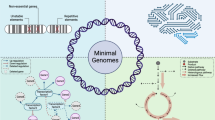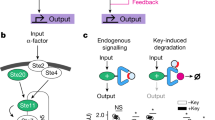Abstract
Synthetic biology, despite still being in its infancy, is increasingly providing valuable information for applications in the clinic, the biotechnology industry and in basic molecular research. Both its unique potential and the challenges it presents have brought together the expertise of an eclectic group of scientists, from cell biologists to engineers. In this Viewpoint article, five experts discuss their views on the future of synthetic biology, on its main achievements in basic and applied science, and on the bioethical issues that are associated with the design of new biological systems.
This is a preview of subscription content, access via your institution
Access options
Subscribe to this journal
Receive 12 print issues and online access
$189.00 per year
only $15.75 per issue
Buy this article
- Purchase on Springer Link
- Instant access to full article PDF
Prices may be subject to local taxes which are calculated during checkout
Similar content being viewed by others
References
Hasty, J., McMillen, D. & Collins, J. J. Engineered gene circuits. Nature 420, 224–230 (2002).
Wang, Y. H., Wei, K. Y. & Smolke, C. D. Synthetic biology: advancing the design of diverse genetic systems. Annu. Rev. Chem. Biomol. Eng. 4, 69–102 (2013).
Dymond, J. S. et al. Synthetic chromosome arms function in yeast and generate phenotypic diversity by design. Nature 477, 471–476 (2011).
Khalil, A. S. & Collins, J. J. Synthetic biology: applications come of age. Nature Rev. Genet. 11, 367–379 (2010).
Voigt, C. A. Synthetic biology. ACS Synth. Biol. 1, 1–2 (2012).
Endy, D. Foundations for engineering biology. Nature 438, 449–453 (2005).
Smolke, C. D. & Silver, P. A. Informing biological design by integration of systems and synthetic biology. Cell 144, 855–859 (2011).
Wang, H. H. et al. Programming cells by multiplex genome engineering and accelerated evolution. Nature 460, 894–898 (2009).
Church, G. M. & Regis E. Regenesis: How Synthetic Biology Will Reinvent Nature and Ourselves (Basic Books, 2012).
Win, M. N. & Smolke, C. D. Higher-order cellular information processing with synthetic RNA devices. Science 322, 456–460 (2008).
Bonnet, J., Yin, P., Ortiz, M. E., Subsoontorn, P. & Endy, D. Amplifying genetic logic gates. Science 340, 599–603 (2013).
Mutalik, V. K. et al. Precise and reliable gene expression via standard transcription and translation initiation elements. Nature Methods 10, 354–360 (2013).
Kelly, J. R. et al. Measuring the activity of BioBrick promoters using an in vivo reference. J. Biol. Eng. 3, 4 (2009).
Liang, J. C., Chang, A. L., Kennedy, A. B. & Smolke, C. D. A high-throughput, quantitative cell-based screen for efficient tailoring of RNA device activity. Nucleic Acids Res. 40, e154 (2012).
Michener, J. K. & Smolke, C. D. High-throughput enzyme evolution in Saccharomyces cerevisiae using a synthetic RNA switch. Metab. Eng. 14, 306–316 (2012).
Czar, M. J., Anderson, J. C., Bader, J. S. & Peccoud, J. Gene synthesis demystified. Trends Biotechnol. 27, 63–72 (2009).
Carr, P. A., Sun, Z. Z., Xu, G., Forest, C. R. & Church, G. M. Programming cells by multiplex genome engineering and accelerated evolution. Nature 460, 894–898 (2009).
Gibson, D. G. et al. Complete chemical synthesis, assembly, and cloning of a Mycoplasma genitalium genome. 339, 819–823 (2008).
Cong, L. et al. Multiplex genome engineering using CRISPR/Cas systems. 319, 1215–1220 (2013).
Xia, B., Leguia, M., Anderson, J. C. & Densmore, D. Eugene — a domain specific language for specifying and constraining synthetic biological parts, devices, and systems. PloS ONE 6, e18882 (2011).
Czar, M. J., Cai, Y. & Peccoud, J. Writing DNA with GenoCAD™. Nucleic Acids Res. 37, W40–W47 (2009).
Hillson, N. J., Rosengarten, R.D. & Keasling, J.D. j5 DNA assembly design automation software. ACS Synth. Biol. 1, 14–21 (2011).
Tran, A. B., Paull, M., Keasling, J. D., Arkin, A. P. & Endy, D. Precise and reliable gene expression via standard transcription and translation initiation elements. Nature Methods 10, 354–360 (2013).
Brophy, J. A. N., Clancy, K., Peterson, T. & Voigt, C. A. Characterization of 582 natural and synthetic terminators and quantification of their design constraints. Nature Methods 10, 659–664 (2013).
Rhodius, V. A. et al. Design of orthogonal genetic switches based on a crosstalk map of σs, anti-σs, and promoters. Mol. Syst. Biol. 9, 1–13 (2013).
Stanton, B. C. et al. Genomic mining of prokaryotic repressors for orthogonal logic gates. Nature Chem. Biol. 10, 99–105 (2014).
Schirmer, A., Rude, M. A., Li, X., Popova, E. & del Cardayre, S. B. Microbial biosynthesis of alkanes. Science 329, 559–562 (2010).
Mali, P., Esvelt, K. M. & Church, G. M. Cas9 as a versatile tool for engineering biology. Nature Methods 10, 957–963 (2013).
Ruder, W. C., Lu, T. & Collins, J. J. Synthetic biology moving into the clinic. Science 333, 1248–1252 (2011).
de Jager, V. et al. antiSMASH: rapid identification, annotation and analysis of secondary metabolite biosynthesis gene clusters in bacterial and fungal genome sequences. Nucleic Acids Res. 39, W339–346 (2011).
Tumpey, T. M. et al. Characterization of the reconstructed 1918 spanish influenza pandemic virus. Science 310, 77–80 (2005).
Lajoie, M. J. et al. Genomically recoded organisms impart new biological functions. Science 342, 357–360 (2013).
Lajoie, M. J. et al. Probing the limits of genetic recoding in essential genes. Science 342, 361–363 (2013).
Elowitz, M. & Lim, W. A. Build life to understand it. Nature 468, 889–890 (2010).
Danino, T. et al. A synchronized quorum of genetic clocks. Nature 463, 326–330 (2010).
Stricker, J. et al. A fast, robust and tunable synthetic gene oscillator. Nature 456, 516–519 (2008).
Fung, E. et al. A synthetic gene-metabolic oscillator. Nature 435, 118–122 (2005).
Elowitz, M. B. & Leibler, S. A. Synthetic oscillatory network of transcriptional regulators. Nature 403, 335–338 (2010).
Gardner, T. S., Cantor, C. R. & Collins, J. J. Construction of a genetic toggle switch in Escherichia coli. Nature 403, 339–342 (2000).
Nandagopal, N. & Elowitz M. B. Synthetic Biology: integrated gene circuits. Science 333, 1244–1248 (2011).
Acknowledgements
G.M.C. is supported by grants from the US Department of Energy (DOE), US Defense Advanced Research Projects Agency (DARPA), US National Human Genome Research Institute (NHGRI), US National Science Foundation (NSF) and Personal Genome Project (PGP). C.D.S. is supported by funds from the US National Institutes of Health (NIH), NSF, DARPA, Human Frontiers Science Program (HFSP), and Bill and Melinda Gates Foundation.
Author information
Authors and Affiliations
Corresponding authors
Ethics declarations
Competing interests
The authors declare no competing financial interests.
Related links
Related links
FURTHER INFORMATION
Glossary
- CRISPR
-
(Clustered regularly interspaced short palindromic repeats). An adaptive immune system that is found in bacteria and archaea, which is based on an RNA-guided nuclease (Cas9). Components of the CRISPR system are being repurposed to provide powerful, flexible and precise genome engineering, and regulatory systems across diverse species.
- Genetic switches
-
Natural or synthetic systems for regulating gene expression in response to one or more external or internal signals. The output of genetic switches is often a complex logical function of input signals that in many cases can provide a persistent response to transient inputs or other capabilities.
- Genomically recoded organisms
-
(GROs). Changing every instance in a genome of one or more of the 64 codons in the genetic code for higher safety and productivity.
- Multiplex-automated genome engineering
-
(MAGE). Efficient genome editing that is capable of making dozens of changes per genome and billions of genomes by inserting short (90 bases long) single-stranded DNA into the cellular replication fork with one or more DNA changes.
- Optogenetics
-
A technique to control and perturb cellular behaviour using light and genetically encoded light-sensitive proteins. It has been extensively used to precisely control neuronal activity spatially and temporally through light.
- Oscillator
-
Produces oscillations that underlie diverse biological behaviours from neurobiology to multicellular development. Synthetic biology has shown that remarkably simple circuit designs can produce clock-like oscillations of protein levels in individual living cells.
Rights and permissions
About this article
Cite this article
Church, G., Elowitz, M., Smolke, C. et al. Realizing the potential of synthetic biology. Nat Rev Mol Cell Biol 15, 289–294 (2014). https://doi.org/10.1038/nrm3767
Published:
Issue Date:
DOI: https://doi.org/10.1038/nrm3767
This article is cited by
-
Modelling genetic stability in engineered cell populations
Nature Communications (2023)
-
Nanoscale programming of cellular and physiological phenotypes: inorganic meets organic programming
npj Systems Biology and Applications (2021)
-
Optimizing the dynamics of protein expression
Scientific Reports (2019)
-
Regulation and regime: the comparative politics of adaptive regulation in synthetic biology
Policy Sciences (2019)
-
Multi-objective optimization of genome-scale metabolic models: the case of ethanol production
Annals of Operations Research (2019)



